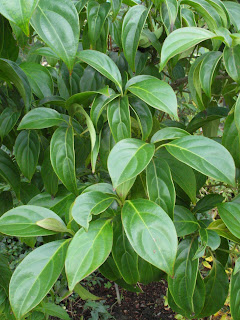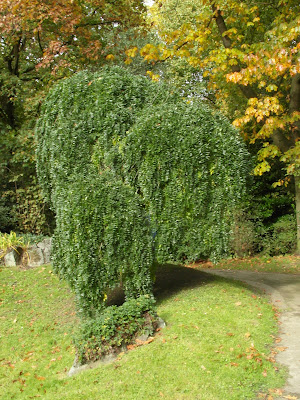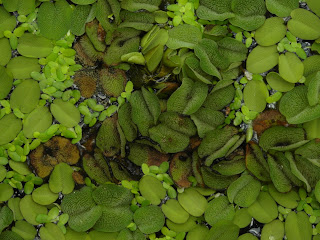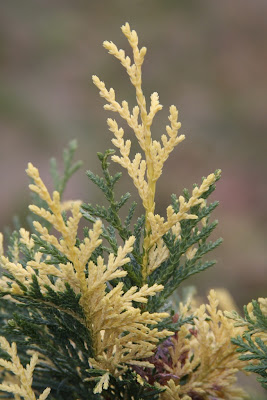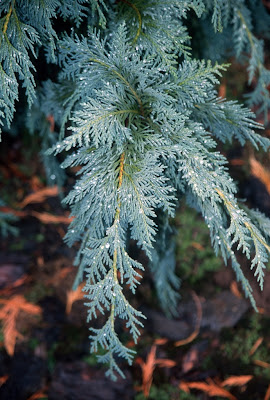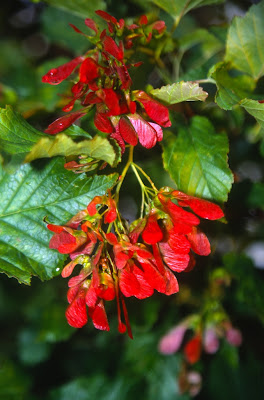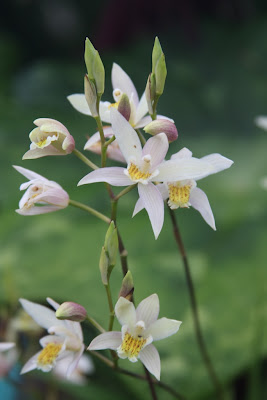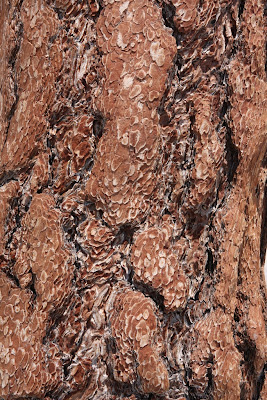As any regular reader of this blog knows, I have a "thing" about plant names. The "thing" that I want to know is why a certain name was selected for a certain plant. I always wonder: what is the source, the origin, the whence of everything. Nothing annoys me more than to encounter an interesting plant, and then be unable to identify it.
What is it, or rather, who is it? Who's its name? If I can't find out, I feel left out. But Haruko, my wife, couldn't care less. She cares more about the shadow that a tree casts, than about the tree's name; more about the sound of a tree's leaves in the wind; more about a tree's shakkei (Japanese, for its relationship to its further landscape), than the tree's name. I can allow for all of that. But still, I want to know: how did it get its name? Why? What's the history? What is his story?
We must acknowledge Carl Linne (who loved Latin so much that he changed his name to Carolus Linnaeus) for creating the binomial system for plants, where every genus is comprised of species, all based upon the perception of a relationship of similarities. For example, a plum is similar to a cherry, therefore both belong to the genus Prunus. Cultivar names (cultivated variants) used to be given in Latin, but now it's more often a name used as a marketing ploy, to provide something catchy and memorable. So we have genera, like Hosta, with the most goofy of names, like 'X-rated', 'Teeny-weeny Bikini', 'Pandora's Box' and 'Blue Mouse Ears'.
![]() |
| Cornus x 'Dorothy' |
I'm on record as disapproving of the use of people's names for cultivars, and yet I have done so myself. Dorothy, a wonderful ninety-year-old gardening woman from Vancouver, Washington had a spontaneous dogwood hybrid (between Cornus florida and Cornus nuttallii) in her yard. The tree was lovely in flower, and so was Dorothy, so I propagated it – to her delight – and named it for her. I even thought about dating her, in spite of our age difference, but then I had just met my current wife, and Haruko's flesh and smile proved the stronger attraction. Dorothy has passed away now, but her dogwood remains, and therefore so does she.
![]()
Chamaecyparis nootkatensis 'Laura Aurora'
![]() |
| Chamaecyparis nootkatensis 'Laura Aurora' |
I have a sketchy record about naming cultivars, as I have used English names, Japanese names, and sometimes multi-language names, which is nomenclaturally illegal. I was taken to task by a European dendrological expert for naming a dwarf, variegated "Weeping Alaskan Cedar," Chamaecyparis nootkatensis 'Laura Aurora', that I shouldn't use "Laura," an English name, he supposed, and combine it with the Latin "Aurora." I thought the criticism was entirely unfounded. The name Laura originated in Latin Europe, and was derived from the "Bay Laurel" plant, or Laurus nobilis, which in Greco-Roman times was used as a symbol of victory, honor or fame. The name Aurora originates from the Latin word for "dawn." So "Laura Aurora" is hoyle, dammit, with a nice ring to it besides. With its yellow variegated foliage, the cultivar is bright and cheerful, the same as my daughter Laura.
![]()
Chamaecyparis nootkatensis 'Sparkling Arrow'
![]()
Chamaecyparis nootkatensis 'Green Arrow'
I named another cultivar of "Weeping Alaskan Cedar," Chamaecyparis nootkatensis 'Sparkling Arrow'. Good, two English words. Its origin was a variegated shoot on a 'Green Arrow', and fortunately it makes a wonderful, narrow weeping tree as well, only with some extra color. 'Green Arrow' was discovered and named (brilliantly, I think) by the late Gordon Bentham, and the original tree was on Canadian federal forestry land. Bentham asked the Feds for permission to harvest a few scions, but was denied. He had paid a lifetime of Canadian taxes, was a life-long citizen, and harbored the notion that the tree was his anyway, and no stinking smug government employee should interfere with him. Bentham obviously harvested the scionwood, and he told me about it shortly before his death in the early 1980's. I visited the old bankrupt Canadian nursery (Den Allen) and discovered the trees in one-gallon pots. A Danish intern was the only employee in the weed patch, and I asked if I could buy the trees. I think because of his nervousness about his next paycheck, he agreed, and I returned to the States with a dozen three-year-old starts, one of which is in the photo above, and which could be the largest 'Green Arrow' in the world, outside of the original. If the intern had not sold me the plants, maybe the original grafts would have been tossed, for the expired nursery, on prime real estate, is perhaps a shopping mall now.
![]()
![]()
Acer palmatum 'Geisha Gone Wild'
I named an excellent new maple, Acer palmatum 'Geisha Gone Wild', because the original mutation on an Acer palmatum 'Geisha' had indeed "gone wild." I suppose the crabby European dendrologist would have a problem with that name too: with "Geisha," a Japanese word, followed by two English words.
![]() |
| Acer palmatum 'Midori no teiboku' |
![]() |
| Acer palmatum 'Midori no teiboku' |
The late Dr. Corbin of Portland, Oregon was a dear friend and an avid maple collector. He grew a laceleaf with green foliage and a low, dense habit; the mother tree was Acer palmatum 'Viridis'. I thought the seedling had ornamental merit, so I propagated it and temporarily named it 'V. Corbin'. A number of customers liked the plant also, and many left my nursery with that code-name. It even made it into the Vertrees-Gregory book, Japanese Maples, third edition. That was too bad, for earlier I gave it an "official" name, 'Midori no teiboku'. In the fourth edition Gregory made the correct update, but it helped me to realize that I should never sell or give away any plant without a final, lasting name. Also, it is ok – and often beneficial – to name a plant early, even if it is largely untried and unproven, without a decade or more of in-house observation. The marketplace will then determine the worthiness of your named plant. By the way 'Midori no teiboku' is a lousy name too. I had a couple of Japanese interns at the time, and I asked them how would you say "green, and low and spreading" in Japanese. "Ooo, ahh," they conferred for fifteen minutes, and just as I was about to tell them to forget it, by consensus they came up with 'Midori no teiboku'. A few years later, my Japanese wife said that technically the name was sound, but that nobody would say it that way. But, too late.
![]() |
| Sequoia sempervirens |
![]() |
| Sequoiadendron giganteum |
Enough about cultivar names, let's discuss the given names of genera and species. The first person to successfully argue that a certain plant is unlike anything else, gets to choose both the genus and the species name. Or, if one (Buchholz) argues that two species should not be in the same genus, such as Sequoia sempervirens and Sequoiadendron giganteum, his name will follow the new botanic name in reference books.
![]() |
| Toxicodendron diversilobum |
I'll begin with our native, "Pacific Poison Oak," Toxicodendron diversilobum, since it grows on my property, down next to the Tualatin River. The genus refers to a "toxic tree," and certainly it is. One should identify and respect it early on in life, or else you'll pay, as I did twice in my youth. Diversilobum refers to the three leaves which point in different directions. The plant itself is somewhat attractive with its glossy foliage, and it's the first deciduous plant to turn dark red, long before everything else does, often the end of August.
![]() |
| Acer palmatum |
![]() |
| Acer palmatum |
![]()
Cercis canadensis 'Appalachia'
![]() |
| Cercis siliquastrum |
Acer, not the computer company, but the genus of maples, is derived from the Latin word ācer, meaning sharp, as the lobes are often pointed, and should properly be pronounced as ahker. Acer circinatum is so named due to its round leaves, which is Neo-Latin from Linnaeus, and that derived from Greek kerkis, or "Redbud," probably Cercis siliquastrum, the "Judas Tree," the tree that Judas supposedly hanged himself from.
![]() |
| Acer japonicum |
![]()
Acer nipponicum
![]() |
| Acer tataricum |
![]()
Acer tataricum
![]() |
| Acer tataricum ssp. ginnala 'Little Elf' |
Acer japonicum denotes a tree coming from Japan, and so does Acer nipponicum, while Acer tataricum refers to a maple that comes from the land of the Tartars, the Great Steppe which reaches from the Ural Mountains to the Pacific Ocean. This species name was coined by Linnaeus in 1753. The subspecies ginnala refers to its vernacular name, coming from the Amur region in central China. We even introduced a dwarf form, 'Little Elf', which arose as a seedling, and grows to only 2' tall by 2' wide in ten years.
![]() |
| Cathaya argyrophylla |
![]()
Cathaya argyrophylla
![]()
Cathaya argyrophylla
Cathaya is a monotypic genus from China. It was named to honor Cathay, the old name for the "Celestial Empire." The name was used by Marco Polo, and was a corruption of the Tartar name for north China – Khitai, or the land of the Khitans. The species name, argyrophylla, translates as "silvery leaves," as the needles are glossy green above, with showy silvery undersides. A form, nanchuanensis, can be found near Kunming, Yunnan, China, or so I now read, but I wasn't aware of that when I was in the city in the 1980's. Heck, I had never heard of the genus Cathaya in the 1980's.
Cryptomeria japonica
![]()
Cryptomeria japonica
Cryptomeria japonica, from Japan of course, is referred to as "sugi," and commonly called the "Japanese Cedar." The origin of Cryptomeria is modern Latin crypto, from Greek kryptos, meaning hidden; and meros, a "part." All because the seeds are hidden by scales. David Don, a Scottish botanist, was involved in naming Cryptomeria, and D. Don is often used after the botanical name. Don was a professor of botany at Kings College in London, and also a librarian of the Linnean Society of London from 1822 until his death in 1841. He was in the right place at the right time to put his stamp after many great conifers, such as the "Coast Redwood," Taxodium sempervirens, now Sequoia sempervirens; the "Santa Lucia Fir," Pinus bracteata, now Abies bracteata; and the "Grand Fir," Pinus grandis, now Abies grandis.
![]() |
| A Pleione garden |
![]() |
| Pleione 'Ridgeway' |
![]() |
| Pleione 'Versailles' |
![]() |
| Pleione 'Alishan' |
David Don also named the genus Pleione, a group of hardy (for me) ground orchids that I at first grew as a hobby but also now for profit. In Greek mythology, Pleione was an Oceanid nymph, from southern Greece, and was the protectress of sailing. I would have loved to have met her, or I still would love to meet her.
![]() |
| Bletilla striata 'Alba' |
![]() |
| Bletilla striata 'Alba' |
Similarly, we have the genus Bletilla, another terrestrial orchid from eastern Asia. The species striata, is from the Latin word striatus, meaning "striped," in reference to the striped floral parts. I grow Bletilla striata 'Alba', a delightful little treat, as shown above. The name Bletilla is after one Louis Blet, a botanist and apothecary (today a pharmacist).
![]()
Bletilla ochracea
The "Chinese Butterfly," Bletilla ochracea, from western Africa and south Asia, is used by "healers" to cure "vampire disease," and God help them for that. It treats bacterial infections and prevents malaria, and is also used to treat anthrax infection. So, there you have the details, or do you? The species name refers to its Latin word meaning, "ochraceous," or ochre-colored, which is any of various natural earths which contain ferric oxide, silica or itilumia, which are used as red or yellow pigments.
![]() |
| Pinus ponderosa |
Pinus ponderosa
When you ponder, you think about or weigh an idea or a situation. That has its origin in the Old French ponderer, from Latin ponderare to weigh, from pondus, weight. Pinus ponderosa, or the huge "weighty pine," was considered by David Douglas to be the largest, most ponderous, of all the new-world pines.
![]() |
| Pinus jeffreyi |
![]() |
| Pinus jeffreyi at Yosemite |
![]() |
| Pinus jeffreyi at Yosemite |
![]()
Pinus jeffreyi
Close in appearance to Pinus ponderosa is Pinus jeffreyi, named in honor of botanist/collector John Jeffrey. The range of Pinus jeffreyi begins in southern Oregon, and extends down the eastern length of California, mostly found at higher elevations in the Sierras, as opposed to the more lowland range of ponderosa. Needles are in fascicles of three, and are long and gray-green in color, but have the quality to shimmer in sunlight. Ponderosa emits very little odor, but jeffreyi's resin can smell like vanilla, lemon or pineapple, and once in a tree book I read that it smelled like butterscotch. I've never been able to detect butterscotch, but I have used the smell test to determine the species numerous times in the Sierra.
Pinus ponderosa can be used to distill turpentine, but jeffreyi contains exceptional purity of n-heptane, and can explode when ignited. The distiller must know exactly which species he is using.
![]() |
| Pinus jeffreyi 'Joppi' |
![]() |
| Pinus jeffreyi 'Joppi' |
![]() |
| Pinus jeffreyi 'Joppi' |
We grow one cultivar of Pinus jeffreyi, 'Joppi', and it is a dwarf form which originated as a seedling in Vergeldt's Nursery in the Netherlands, and named for his son. Site it carefully, however, as it can eventually grow quite large.
![]() |
| Pinus jeffreyi 'Gold' |
We also collected one plant of Pinus jeffreyi 'Gold' which colored brilliantly in winter, but unfortunately lost it in transplanting. The photo of 'Gold' above was taken in October, and was a non-event at the time, as you can see.
John Jeffrey was a Scottish botanist who worked as a gardener in Edinburgh's Royal Botanic Garden, a wonderful plant collection I have visited three times. Jeffrey was sent to America's west coast to carry on the work of David Douglas (1799-1834). He was tough, as he walked from Hudson's Bay all 1200 miles to reach the Columbia River at the age of 24. He explored for four years in Oregon, Washington and California, sending plant material back to Scotland. But in 1854 he disappeared and was never heard from again, presumed dead at age 28. Whenever I'm in California, I have a fantasy that I would stumble upon his remains, maybe pulling specimens and field notes out of his bag. David Douglas was also a tough Scotsman, who regularly walked twenty miles a day, and he perished at age 35.
![]() |
| Tsuga x jeffreyi |
![]() |
| Tsuga heterophylla (?) 'Iron Springs' |
![]() |
| Tsuga heterophylla |
One final plant is Tsuga x jeffreyi, a natural hybrid between Tsuga mertensiana and Tsuga heterophylla, and a stand has been located in Washington state, east of the Cascades. It looks more mertensiana than heterophylla to me, and was once considered just a variation of mertensiana. The photo above of x jeffreyi was taken at the Gimborn Arboretum in The Netherlands. A cultivar of Tsuga heterophylla, supposedly, is 'Iron Springs', but I wonder if it is perhaps the hybrid. I laugh when knuckleheads list 'Iron Springs' as a "dwarf," as my 28-year-old specimen is already over twenty feet tall.
So, there's just a sample of my origin obsession, my derivement compulsion. One can obviously get carried away and squander a lot of time...and it's noon now and I'm hungry. But, let's see: what is the origin of the word "lunch?"...from Spanish (1812) short for luncheon, a light meal in the middle of the day. For breakfast I had an omelette, from French for a "small pan," although one time an omelette world record was set using 160,000 eggs in Yokohama, Japan. For dinner, from Old French disner.....
![]() |
| Buchholz preaching plant names |

























































































































































































































































































































































































